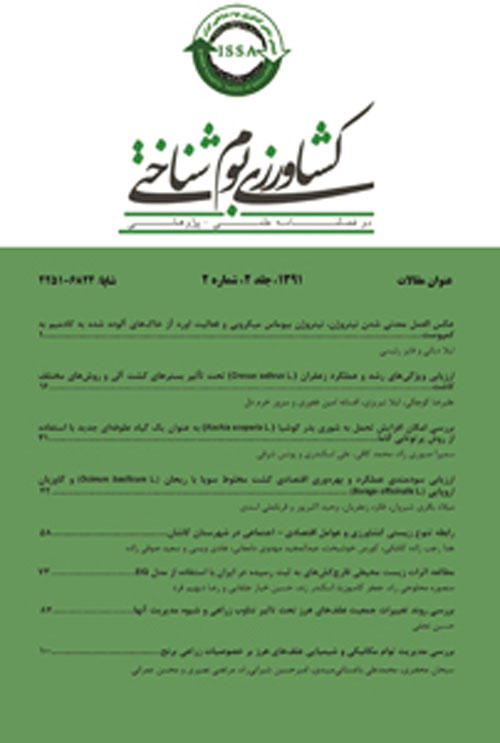Effects of humic acid and nitrogen ratios on the leaf physiology and root biochemistry of strawberry plants
Author(s):
Article Type:
Research/Original Article (دارای رتبه معتبر)
Abstract:
Introduction
Humic acid is a natural organic compound that results from the decay of organic soil matter. It is used to increase yield and product quality (Motagh and Nejad, 2014). It is the most active compound of soil and organic matter that increases plant growth and thereby yield (Nikbakh et al., 2008). The organic matter in humic compounds possibly contains material that would serve as a substrate for the production of physiologically active compounds (Zandonadi et al., 2013). This research was conducted with the aim of reducing the use of chemical fertilizers especially nitrogen and also extending strawberry cultivation in different climatic conditions.Materials And Methods
In order to evaluate the effects of humic acid and nitrogen fertilizer on the biochemical and physiological properties of strawberry, a split-split-plot experiment in a randomized complete block design with three replications was carried out with foliar and soil applications of humic acid treatments, each with four levels (control, 2, 4 and 6 kg per hectare) and nitrogen fertilizer with three levels (50, 100 and 150 kg per hectare). In this study, levels of nitrogen were arranged in main plots and sub-plots and humic acid application c in sub-sub plots. Proline content, soluble sugars, starch, protein content, phenols in roots, cell membrane permeability, osmotic potential, and relative water content of leaves were measured.Results and
Discussion
The results showed that biochemical interactions among nitrogen fertilizer, application method and the concentration of humic acid have significant effects. There were no treatments that did not affect the membrane integrity while relative water content and osmotic potential were influenced by the nitrogen and humic acid concentrations. Nitrogen and humic acid had a positive impact on traits. The treatments consisting of 100 kg of nitrogen and 2 kg of humic acid had the highest value for means of assessed traits. Application of humic acid to the soil showed a positive impact on biochemical traits compared to the spraying method. Increasing the solublity and release of nutrients by humic substances, the result is more absorption of the material by the roots and it was observed to be one of the main factors for the positive effects of humic acid on the amount of compounds in the root of the plant (Kauser and Azam, 1985º, Pinton et al., 1999.(Conclusion
Integrated application of humic acid with nitrogen fertilizer, improved nitrogen uptake and use efficiency. The best results were obtained with an application of 100 kg nitrogen per hectare. It was also observed that a better result was obtained from the use of humic acid in the soil compared to the foliar spraying method. The application of 2 kg/ha-1 of humic acid and 100 kg of nitrogen per hectare is suitable for suitable strawberry yield and quality and increased resistance to various unfavorable environmental conditions. Keywords:
Language:
Persian
Published:
Journal of Agroecology, Volume:8 Issue: 1, 2018
Page:
124
magiran.com/p1846635
دانلود و مطالعه متن این مقاله با یکی از روشهای زیر امکان پذیر است:
اشتراک شخصی
با عضویت و پرداخت آنلاین حق اشتراک یکساله به مبلغ 1,390,000ريال میتوانید 70 عنوان مطلب دانلود کنید!
اشتراک سازمانی
به کتابخانه دانشگاه یا محل کار خود پیشنهاد کنید تا اشتراک سازمانی این پایگاه را برای دسترسی نامحدود همه کاربران به متن مطالب تهیه نمایند!
توجه!
- حق عضویت دریافتی صرف حمایت از نشریات عضو و نگهداری، تکمیل و توسعه مگیران میشود.
- پرداخت حق اشتراک و دانلود مقالات اجازه بازنشر آن در سایر رسانههای چاپی و دیجیتال را به کاربر نمیدهد.
In order to view content subscription is required
Personal subscription
Subscribe magiran.com for 70 € euros via PayPal and download 70 articles during a year.
Organization subscription
Please contact us to subscribe your university or library for unlimited access!


